Current form 27 March 1992 Minister of defense Zoran Jolevski | Chief of the General Staff Metodija Velickovski Budget 108.2 million USD (2017) Founded 14 February 1992 Military age 18 | |
 | ||
Service branches 1st MIB Air Force Special Forces Commander-in-Chief President Gjorge Ivanov Available formilitary service 532,856 males, age 16-49,513,684 females, age 16-49 Fit formilitary service 444,247 males, age 16-49,427,556 females, age 16-49 Similar Military of Moldova, Luxembourg Army, Military of San Marino, Armed Forces of Malta, Albanian Armed Forces | ||
The Army of the Republic of Macedonia (Macedonian: Армија на Република Македонија) is the name of the armed forces of the Republic of Macedonia. Responsible for defending the sovereignty and territorial integrity of Macedonia from foreign hostiles, the Macedonian military is a defence force consisting of an Army (Армија) and Air Force (Воено Воздухопловство). From 2005 the army is composed entirely of professionals and volunteer soldiers, fully transformed into a professional army compatible with NATO standards.
Contents
- Basis of the National Defence Policy And Doctrine
- ISAF
- EUFOR Althea
- Iraqi Freedom
- Support for KFOR
- UNIFIL
- Organization
- Joint Operations Command
- Macedonian Mechanized Infantry Brigade
- Macedonian Aviation Brigade
- Special Operations Regiment
- Logistics Support Brigade
- Other commands
- Command for Training and Doctrines
- Retired Equipment
- References
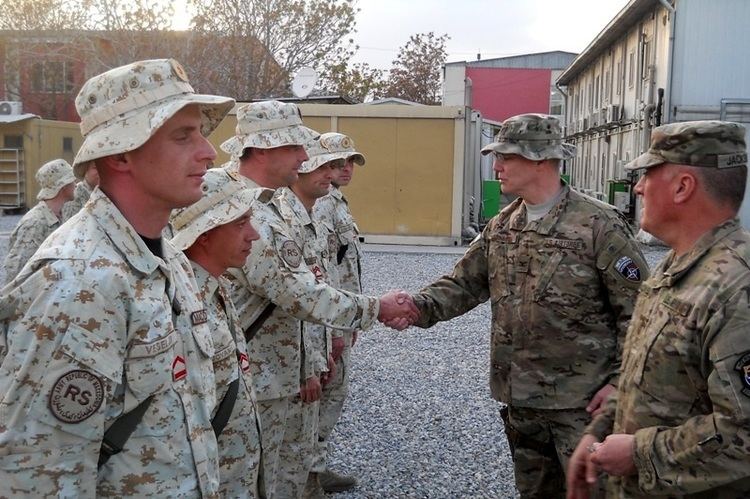
Basis of the National Defence Policy And Doctrine
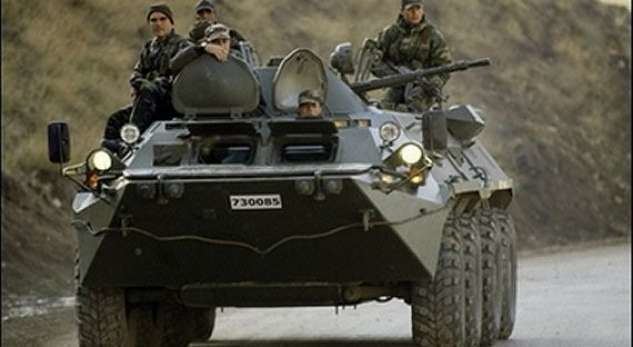
The national defence policy and doctrine are determined and based upon the following basic security policy goals of the Republic of Macedonia:
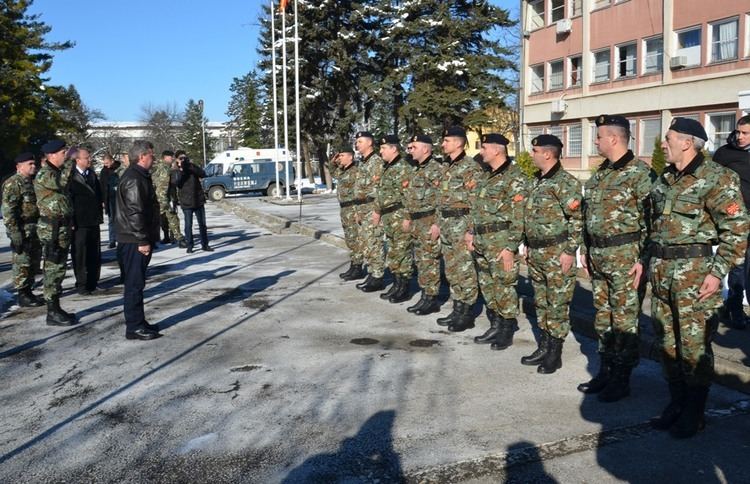
Our security policy sticks strategic to the following determinations in order to accomplish these goals:

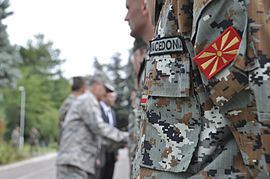
Starting out from the security policy provisions and goals, the defence policy of the Republic of Macedonia is based upon the following principles:
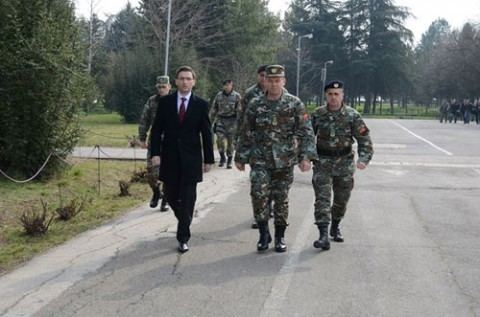
The political defence strategy of the Republic of Macedonia bases upon:
The Republic of Macedonia maintains a defensive potential and combat readiness of its Armed Forces which function as a deterring factor in case of a potential aggression in accordance with our capabilities and international arrangements. In accordance with the Article 123 of the Constitution of the Republic of Macedonia, no one in the state has the right to declare capitulation. Therefore, the defence system of the Republic of Macedonia is based on the determination to give resistance by use of an armed force against any possible aggression and for a defensive combat on the whole territory. For that purpose, the defence system is responsible to provide conditions so that all of the state authorities and institutions function and conditions for joining the collective defence and security systems as a protection of the independence and sovereignty are provided.
The Republic of Macedonia could maintain all the guarantees for its security through the collective defence and security systems. That is why, the Republic of Macedonia supports the reinforcement of these collective systems and determines itself to actively participate in these systems and to cooperate with regard to the construction of the new European security architecture based upon NATO, OSCE and WEU.
In order to fulfill these principles and strategic goals, the defence system of the Republic of Macedonia is a completed with the peacetime and warfare organisation, the basic development goals, the preparations and the use of the Armed Forces as well as the full civilian control over the Armed Forces. The defence system comprises the whole defence potential of the country: civilians, state authorities, civil protection forces, local self-management, public institutions and services and enterprises of special significance for the defence.
The preparations for a successful defence are conducted during peacetime. These include preparations of the state authorities; preparations and training of the Armed Forces and their deployment on the territory of the Republic of Macedonia; preparation of the public institutions and the local self-management; preparations of the civil population and participation in joint exercises and other forms of co-operation with the PfP and NATO member countries.
National Command Management
The management and the procedures in the field of defence of the Republic of Macedonia are defined by the Constitution, the Defence Law and by the responsibilities of the executive and judicial authorities.
The commanding with the Armed Forces is based upon the uniformity in command when using the forces and the resources, and the responsibility to execute the decisions and the orders of the one that is superior in command.
The President passes the defence plan and strategy, the decisions for readiness conducting, organisation and formation structure of the Army, passes documents on development, decision on mobilization etc.
The President at the same time is the Chairman of the Security Council of the Republic of Macedonia. The Security Council considers all the defence and security related issues of the Republic of Macedonia and makes recommendations to the Parliament and to the Government.
The Parliament of the Republic of Macedonia supervises the competence of the Government with regard to the defence, it passes decisions on the existing of a direct threat from a war, declares warfare situation and peace and passes the defence budget.
The Parliamentary Interior Policy and Defence Commission has similar responsibilities.
The Government of the Republic Macedonia has the following responsibilities: proposes the defence plan, the defence budget etc.
The Ministry of Defence develops the defence strategy and works out the assessment of the possible threats and risks. The MOD is also responsible for the defence system, training, readiness of the Armed Forces, the equipment and the development and it proposes the defence budget, etc.
ISAF
The Republic of Macedonia began its participation in the NATO-led ISAF operation in August 2002, with the allocation of two officers to the Turkish contingent. On 8 September, independence day of the Republic of Macedonia, the Macedonian flag was flown for the first time in Kabul. In March 2003, the Army of the Republic of Macedonia increased its contribution in the ISAF mission by sending one section from the 2nd Infantry Brigade as part of the German contingent. As a result of the successful execution of the mission and the high marks received for participation in ISAF, from August 2004 until the end of 2006, the ARM participated with one mechanized infantry platoon from the Leopard unit. At the same time, in August 2005 medical personnel was sent in ISAF as part of the Combined Medical Team in the A3 format (Macedonia, Albania, Croatia), which successfully carried out tasks at the Kabul airport, firstly in the composition of the Greek Field Hospital, and later in the composition of the Czech Field Hospital.
Based on the assessments of the Alliance in the part of the declared units from the ARM, which achieved the required strict standards in the field of training and operational procedures, and in line with the Operational Capabilities Concept (OCC), the ARM in June 2006 sent also one mechanized infantry company, part of the first mechanized infantry brigade, in the composition of the British contingent in ISAF. The trust shown from the United Kingdom towards the ninety "Scorpions" from the first infantry brigade, was justified in full.
The high marks from the highest command structures for the work of the unit as well as the learned lessons are only an imperative for continuing the successful mission. In the second rotation of the company for securing the ISAF command, the Republic of Macedonia increased the participation from ninety to one hundred and twenty seven participants, and from January 2008 it sent three staff officers in the ISAF Command in Kabul.
As a support to the efforts for self-sustainability of the Afghanistan National Army (ANA), beginning from March 2008, the Republic of Macedonia sent two soldiers (one officer and one NCO) as part of the Combined Multinational Operational Mentoring and Liaison Team (OMLT) in Mazar-i-Sharif while, beginning from December 2008, in cooperation with the Kingdom of Norway, a Macedonian medical team is included through one Surgical team in the organizational structure of the surgical unit of the Norwegian Provincial Reconstruction Team (PRT) in Meymanah, Afghanistan.
EUFOR Althea
Contribution of the Republic of Macedonia to the EU Crisis Management Military Operation ALTHEA in Bosnia and Herzegovina
The Republic of Macedonia has reaffirmed its strategic commitment for attaining membership to the EU by its resolute political commitment to support the Common Foreign and Security Policy (CSFP) and by declaring a concrete contribution to the civilian and military operations in the framework of the Common Security and Defence Policy (CSDP). The participation of the Republic of Macedonia in the EU crisis management military operation Althea in Bosnia and Herzegovina marks the first in the series of concrete and substantial contributions that the Republic of Macedonia will provide in the framework of the civilian and military CSDP operations aimed at enhancing the EU capacities. The Agreement between the Republic of Macedonia and the EU on the participation of the Republic of Macedonia in Althea was signed on 3 July 2006, in Brussels. The contribution of the Republic of Macedonia to the EU operation Althea has confirmed its progress from a consumer of the first EU military operation (Concordia 2003) into an active contributor to the CSDP (Althea 2006). The first contribution of the Republic of Macedonia to an EU-led operation began in July 2006, by declaring a helicopter detachment, consisting of two Mi-8/17 helicopters and 21crew. In November 2006, the Republic of Macedonia enhanced its own contribution to the EU operation Althea in Bosnia and Herzegovina by declaring a medical team composed of 10 personnel for providing Role 1 medical support in Camp Butmir.
Iraqi Freedom
Participation in "Iraqi Freedom" mission
With the political consensus of all political entities in the RM as well as the overall Macedonian public in terms of the support of the Coalition in the "fight against terrorism", the Republic of Macedonia took active participation by sending its units in the Iraqi Freedom Mission. Based on all legal authorizations, the Assembly of the Republic of Macedonia adopted decisions for sending its units to the Iraqi Freedom Mission in the period between June 2003 and December 2008 for each mission separately every 6 months during the term of the mission.The Mission started by sending 2 officers in the US Central Command in Tampa, in March 2003. Upon the completion of the major combat operations, the toppling of Saddam Hussein’s regime, and the adoption of Resolution 1546 of the United Nations Security Council, in June 2003 on sending a special task platoon that executed the tasks as part of the 4th infantry division of the Multi-National Force Iraq. In 2008, our participation in the Iraqi Freedom Mission was increased by an additional platoon. A total of 11 rotations were conducted between June 2003 and December 2008. The eleventh rotation was the last, which completed our participation in the Iraqi Mission. The overall number of personnel that participated in this mission is 490.
In the execution of the mission, the soldiers and officers faced different challenges, threats and dangers resulting from their mission and profession. During the mission, the ARM representatives showed professionalism, a high level of training and readiness in the execution of the missions. With their dedication, courage, responsibility and patriotism shoulder to shoulder with the US soldiers and the soldiers of the other coalition partners presented our homeland the Republic of Macedonia in a dignified manner and in the best possible light. The greatest confirmation of their success are the 120 medals presented by the US. Thus, we say that they are the best ambassadors of the country.The Army of the Republic of Macedonia gave its specific contribution by assisting in building strong credible democratic institutions and highly trained security forces in Iraq, forces which guarantee the future of their country as well as the stability and security in their environment and beyond.
Support for KFOR
Having in mind the priorities in the part of logistics not only in national terms, but even more in proportion with the requirements and requests of the Alliance, the Host Nation Support Coordination Centre began to work in April 2005 as part of the NATO HQ in Skopje, a project implemented for the first time with a member nation from the Partnership for Peace. The project at the beginning was implemented on proposal of General Blease, who at that time was the Commander of NATO forces in Skopje. At the beginning, the project included 11 officers from the ARM, who successfully completed the training for the obligations related to giving support from the host nation. Promoting the personal professionalism and achievements, in 2006 these officers became the basis of the Coordination Centre, which gradually began the preparations for undertaking the tasks for support to KFOR.
In June 2007, having in mind the large meaning and the projected goals, the Coordination Centre was included in the formation of the Logistics Support Command in the General Staff of the ARM. In this manner as an addition to the participation in the mission in Iraq, Afghanistan, Bosnia and Herzegovina and Lebanon, the ARM participates also in the mission for support to Kosovo.
Thus far more than twenty officers of the ARM are trained to work in the Coordination Centre, which is of major benefit for the planning and support of similar missions in the near future for us.
UNIFIL
Participation of the Republic of Macedonia in the peace mission of the United Nations in Lebanon, UNIFIL
The security and prosperity in global terms depend more and more on the effective multilateral system. The strategic partnership with the Organization of the United Nations, whose Treaty represents the fundamental framework of the international relations, are the priority of the European Union and NATO on the international security scene. Hence, the contribution of the Republic of Macedonia in the military part with respect to the missions led by the Organization of the United National is a confirmation of the effective membership of the Republic of Macedonia in the Organization and its strategic determinations.
Organization
The primary arm of the military in the Republic of Macedonia is the Army of the Republic of Macedonia (ARM). The ARM is commanded by the Minister of Defense through the Chief of the General Staff (CGS) of the ARM. Two Deputy CGS positions include the Deputy CGS for planning, operations and readiness, under whom operates the General Staff of the ARM, and the Deputy CGS for civil-military cooperation.
Joint Operations Command
Controls and co-ordinates the Mechanized Infantry, Aviation and Logistics Support Brigades
Macedonian Mechanized Infantry Brigade
It plays the key role in securing the safety and unity of the territory of the Macedonian republic. The army is divided into the rapid reaction force and strategic reserve forces. The rapid reaction forces represent the main active combat capability of the military and consist of the 1st Mechanized Infantry Brigade. The strategic reserve forces provide reserve brigades that can be called up in times of emergency.
Macedonian Aviation Brigade
Macedonian Air Warfare and Air Defence has an important role as air support element of ground forces and in enhancing flight safety. One of the main goals of the Macedonian Aviation Brigade is to build up an air surveillance system, which will be the cornerstone of the air traffic safety and airspace control. The air component is made up by the Aviation and the Air Defense Forces.It is located in "Alexander the Great" Airport (near Skopje)
Special Operations Regiment
Special Operations Regiment, is the main command for Special Units of the Army of Republic of Macedonia. Under the command of the Special Operations Regiment are, The Special Forces Battalion "Wolves" and The Rangers Battalion as well as a Regimental Headquarters Company and Logistical Support Company.
Special Forces Battalion "Wolves".was formed in 1994. It consists of a Headquarters and an undisclosed number of Special Forces detachments and specializes in covert actions, Foreign Internal Defence assistance, Special Reconnaissance, Counter Terrorist operations, and Drug interdiction tasks. Its members wear the Maroon Beret.
The Rangers Battalion was formed in 2004. It consists of a Headquarters and 3 Reconnaissance and Direct Action Companies, its members wear the Ranger Green Beret.
The Rangers Battalion is well respected amongst its allies and is continually preparing for success in conducting its missions. Since 2004 the unit has gone through an intensive development period and has put maximum effort into improving its operative ability and its readiness to manage all challenges of modern time conflicts.
The Mission of Special Operations Regiment is to provide fully organized, trained and equipped units to perform special operations and conventional specific operations, independently or in cooperation with other units of the Army and other coalition forces, in all weather and land conditions during peace, crisis and war and to support peace and conflict prevention as part of overall efforts to support internal security and foreign policy of the Republic of Macedonia.
Missions outside the Republic of Macedonia
Received award:
Logistics Support Brigade
Formed in 2001, the Logistics Command oversees all combat service support operations, and controls the Land Forces Logistic Base and the Military Hospital. Mission: Planning, organizing, coordinating and executing logistical support to commands and units of the Army of the Republic of Macedonia, of level II and III.
Tasks:
1. Planning, organizing, coordinating and executing logistical support in the following functional areas:
2. Management with materials of all classes of supply for the commands and units of the Army
3. Storage and maintenance of material supplies for ARM according to specified criteria
4. Strengthening the logistics capacity of the Army in conducting training, work in field conditions, combat engagement and participation in missions
5. Coordinating support of allied forces in transit or maintain in the territory of the Republic of Macedonia
6. Execution of logistical support for the administrative bodies and bodies of local self-governments, organizations, associations, etc. (in special circumstances and for special orders and instructions)
Other commands
Chief of General Staff include ELINT Center and the Honor Guard Unit.
Command for Training and Doctrines
Command for Training and Doctrines Organization, coordination and dimensional task of training the individual soldiers, cadets, NCOs and officers of the active and reserve forces, support collective training commands and units of the Army of the Republic and the development of doctrine and lessons learned in the Army of Republic of Macedonia.In particular for meeting NATO requirements.
In order to improve the quality of training of the Army in 1996,were established several centers for basic and specialized training of individual soldiers, and collective training was done in the units. Centers were established to train: infantry, artillery, logistics, border guards, military police and reconnaissance.
